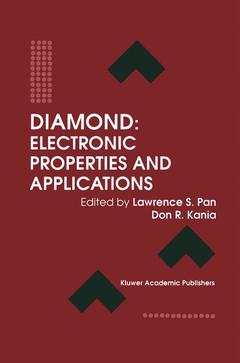Description
Diamond: Electronic Properties and Applications, 1995
Electronic Materials: Science & Technology Series
Coordinators: Pan Lawrence S., Kania Don R.
Language: English
Keywords
crystal; defects; glass; material; semiconductor; semiconductors
Publication date: 02-2014
472 p. · 15.5x23.5 cm · Paperback
472 p. · 15.5x23.5 cm · Paperback
Description
/li>Contents
/li>Comment
/li>
The use of diamond for electronic applications is not a new idea. As early as the 1920's diamonds were considered for their use as photoconductive detectors. However limitations in size and control of properties naturally limited the use of diamond to a few specialty applications. With the development of diamond synthesis from the vapor phase has come a more serious interest in developing diamond-based electronic devices. A unique combination of extreme properties makes diamond partiCularly well suited for high speed, high power, and high temperature applications. Vapor phase deposition of diamond allows large area films to be deposited, whose properties can potentially be controlled. Since the process of diamond synthesis was first realized, great progress have been made in understanding the issues important for growing diamond and fabricating electronic devices. The quality of both intrinsic and doped diamond has improved greatly to the point that viable applications are being developed. Our understanding of the properties and limitations has also improved greatly. While a number of excellent references review the general properties of diamond, this volume summarizes the great deal of literature related only to electronic properties and applications of diamond. We concentrate only on diamond; related materials such as diamond-like carbon (DLC) and other wide bandgap semiconductors are not treated here. In the first chapter Profs. C. Y. Fong and B. M. Klein discuss the band structure of single-crystal diamond and its relation to electronic properties.
1. Electronic and Vibrational Properties of Bulk Diamond.- 1.1 Introduction.- 1.2 Electronic Band Structure of Diamond.- 1.3 Electronic Properties Derived from the Band Structure of Diamond.- 1.4 Vibrational Properties of Diamond.- 1.5 Summary.- Acknowledgment.- References.- 2. Diamond Surface.- 2.1 Introduction.- 2.2 The Clean Surfaces: C(100), C(l 10), C(l 11).- 2.3 Impurity Stabilized Surfaces.- 2.4 Substrate Preparation and Surface Treatments.- 2.5 Surface/Interface Relevance to Electronic Devices.- 2.6 Negative Electron Affinity (NEA) Properties.- 2.7 Summary and Future Outlook.- Acknowledgments.- References.- 3. Growth of CVD Diamond for Electronic Applications.- 3.1 Introduction.- 3.2 Nucleation and Growth Processes.- 3.3 Diamond Reactor Technology.- 3.4 Gas Phase Chemistry.- 3.5 Growth of Electronic Quality Diamond.- 3.6 Summary.- References.- 4. Doped Diamond.- 4.1 Introduction.- 4.2 Natural Diamonds.- 4.3 HP/HT Synthesis.- 4.4 Ion Implantation.- 4.5 CVD Films.- 4.6 Theoretical Calculation.- 4.7 Summary.- References.- 5. Defects in Diamond.- 5.1 Introduction.- 5.2 Twins, Stacking Faults and Dislocations.- 5.3 Point Defects.- 5.4 Non-Diamond Carbon Phases.- 5.5 Other Defects.- 5.6 Summary.- Acknowledgements.- References.- 6. Free Carrier Dynamics in Diamond.- 6.1 Introduction.- 6.2. Electrical Conductivity.- 6.3 Other Transport Properties.- 6.4 Free Carrier Recombination.- 6.5 Summary.- References.- 7. Thermal Conductivity of Diamond.- 7.1 Introduction.- 7.2 Defects in Diamond.- 7.3 Theory of Themal Conduction in Semiconductors.- 7.4 Measurement Techniques.- 7.5 Results for Single Crystals.- 7.6 Results for CVD Diamond.- 7.7 Summary.- References.- 8. Electrical Contacts to Diamond.- 8.1 Introduction.- 8.2 Fabrication of Ohmic Contacts.- 8.3 Fabrication of Schottky Contacts.- 8.4 Mechanisms of Ohmic vs. Schottky Contacts Formation on Diamond.- 8.5 Summary.- Acknowledgments.- References.- 9. Electronic Device Processing.- 9.1 Introduction.- 9.2 Device Design and Substrates.- 9.3 Growth and Doping.- 9.4 Surface Preparation.- 9.5 Contact Formation.- 9.6 Dielectrics.- 9.7 Selective Deposition.- 9.8 Isolation.- 9.9 Summary.- References.- 10. Passive Diamond Electronic Devices.- 10.1 Introduction.- 10.2 Sensors and Microstructures.- 10.3 Junction Devices.- 10.4 Photoconductive and Electron-Beam Controlled Switches.- 10.5 Surface Acoustic Wave Devices.- 10.6 Electrodes.- 10.7 Energy Donversion Devices.- 10.8 Traveling Wave Devices.- 10.9 Other Devices.- 10.10 Summary.- Acknowledgments.- References.- 11. Active Diamond Electronic Devices.- 11.1 Introduction.- 11.2 Diamond Active Electronic Devices.- 11.3 Summary.- References.- Appendix Table A1. Properties of semiconductors at 293 K.
This book gives a complete characterization of the materials, in both intrinsic and doped forms, explains how to grow it for electronic applications, how to use the grown material, and a description of both passive and active devices in which it has been used with success.
© 2024 LAVOISIER S.A.S.




